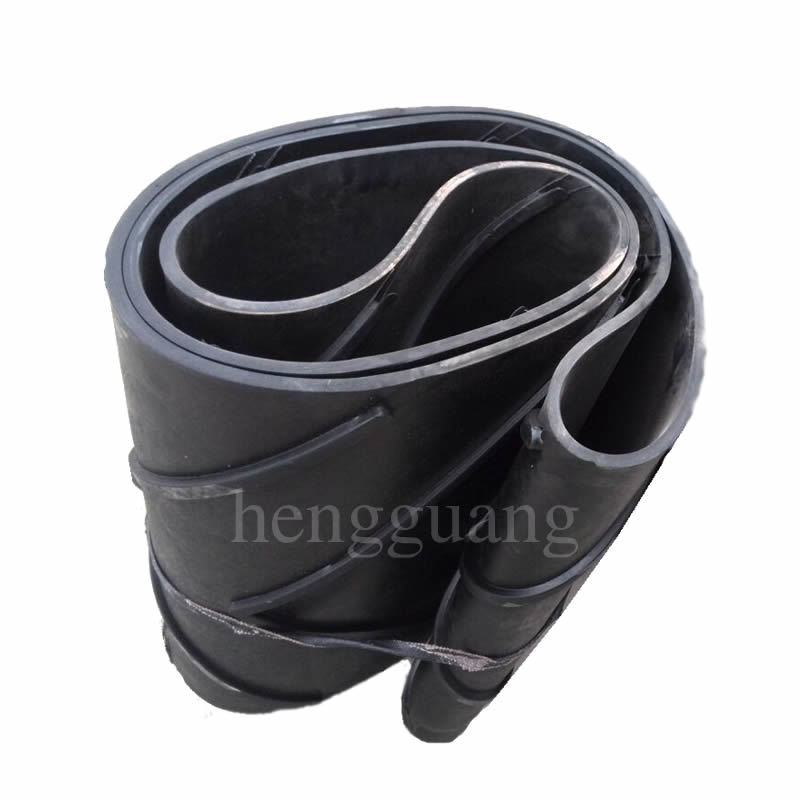Jan. 20, 2020
The belt conveyor machine manufacturer analyzes the wear patterns in 4 different situations, and puts forward some maintenance measures based on the actual production.
03.Local wear caused by the deviation of the conveyor belt
Rubber conveyor belt deviation is a common fault of conveyors, which mainly means that the centerline of the conveyor belt is deviated from the longitudinal centerline of the conveyor when the conveyor is running.
1.Wear causes
The basic reason for the deviation of the conveyor belt is that the side rollers on the two sides of the belt conveyor produce lateral forces when they come into contact with the conveyor belt. When the lateral forces on the two sides are not equal, the deviation of the conveyor belt is caused. A few points:
a) The center line of the conveyor head and the tail roller is not parallel, so that the two sides of the conveyor belt are not tight, and the conveyor belt moves to the tight side;
b) The quality problems of the conveyor belt itself (such as uneven elongation, inflexible bending, etc.), as well as severe wear of the edges of the tape, will cause the tension on the two sides of the conveyor belt to be inconsistent, causing deviations;
c) The joint of the conveyor belt is incorrect;
d) The support roller is not installed correctly, and a biasing force is applied to the conveyor belt;
e) Improper feeding of the conveyor belt causes uneven force on the conveyor belt, causing deviations;
f) The material is bonded to the drum, which causes the radius of the drum to change locally, which causes the conveyor belt to shift laterally.
For the various deviation patterns of the conveyor belt, the following rules are summarized: the conveyor belt runs tight and does not run loose; it runs high and does not run low; it does not run before it runs.
2. Maintenance measures
a) The head and tail rollers are not parallel, and the phenomenon of tight running and loose running occurs.
If the centerline of the entire conveyor is offset, the centerline must be recalibrated; if it is only slightly off, the bearing seat on the tight side can be tightened. However, this method can only adjust small offsets. For large offsets, the tail roller can be installed on the movable car, and the car can be adjusted by adjusting the car.
b) Due to the unevenness of the conveyor belt itself or the incorrect joints, the conveyor belt is unevenly loaded, causing deviations. The conveyor belt should be straightened, glued or nailed again.
c) The axis of the idler roller group is not perpendicular to the centerline of the conveyor belt, causing the phenomenon that the conveyor belt does not run before running, that is, the conveyor belt runs backward (opposite to the running direction of the conveyor belt). The side of the supporting rollers is deflected by 2 ° ~ 4 ° in the direction of the conveyor belt. Generally, it is necessary to adjust several supporting rollers to correct the deviation.
04.Abrasion between roller and conveyor belt
1.Wear causes
The reasons for the formation of abrasion between the backstop idler and the conveyor belt mainly include installation errors, deformation of the idler frame structure, and idler corrosion.
a) Improper installation of the roller frame
Under the support of the supporting rollers, the conveyor belt guarantees its normal operation by generating a certain frictional force. Due to improper installation, the axis of the idler is not perpendicular to the centerline of the conveyor belt, and the conveyor belt relatively slides relative to the idler roller, which aggravates the wear of the conveyor belt.
b) Abrasion caused by alignment rollers
The self-aligning idler produces a certain tilt angle when correcting the deviation. Due to processing quality and rust, the rotary frame is not flexible to rotate and cannot be rotated and reset in time, which will wear the conveyor belt.
c) Roller rotation lag
Due to the quality problems of the idler rollers (such as poor sealing, inflexible bearing rotation, etc.), the rotation of the idler rollers lags the running speed of the conveyor belt, causing relative slippage between the idler rollers and the conveyor belt and abrading the conveyor belt.
2. Maintenance measures
a) First ensure that the entire conveyor is on a center line; secondly, the inclined rollers on both sides have the same inclination angle with the intermediate horizontal rollers, and all the intermediate rollers are on the same horizontal plane, so that all the rollers and the conveyor belt have good Contact to ensure that each roller is evenly stressed.
b) Minimize the use of self-aligning rollers.
c) Strengthen the routine maintenance of the rollers, and replace the damaged rollers in time.
Conveyor belt wear is an inevitable phenomenon during the operation of the belt conveyor. Failure to pay attention to it may lead to failure and shutdown, high maintenance and replacement costs, heavy losses, and even serious accidents. Therefore, it is necessary to take corresponding measures to reduce the wear of the conveyor belt and prolong its service life.

Rubber Conveyor Belt